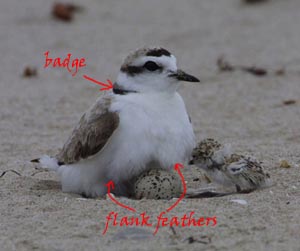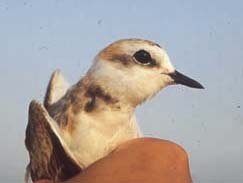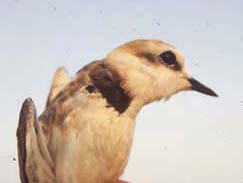
Research at Lake Tuzla, Southen Turkey: Multiple ornaments in the Kentish plovers
 We carried out an
experiment in which we investigated the role of two different
ornaments, each plausibly signalling different male attributes, in
attracting a new mate in the Kentish plover Charadrius
alexandrinus. We created single males by removing their mate
and clutch, and then manipulated both the size of breast bands (badge)
and the length of flank feathers in males.
Specifically, we tested the hypotheses that badges and flank feathers
are used by females in mate choice decisions. We hypothesized that
badge size is a signal of the males' genetic quality or their dominance
status and hence defensive abilities. We also hypothesized that the
length of the flank feathers are signals of the males' parental quality
in incubation, since longer feathers were assumed to provide better
insulation for the eggs and downy chicks. First, we predicted that if
breast bands indicate male quality, then males having enlarged breast
bands would find a mate sooner than males with control breast bands.
Second, we predicted that if long flank feathers indicate parental
ability, then males with shortened flank feathers would need more time
to find a new mate than control males.
We carried out an
experiment in which we investigated the role of two different
ornaments, each plausibly signalling different male attributes, in
attracting a new mate in the Kentish plover Charadrius
alexandrinus. We created single males by removing their mate
and clutch, and then manipulated both the size of breast bands (badge)
and the length of flank feathers in males.
Specifically, we tested the hypotheses that badges and flank feathers
are used by females in mate choice decisions. We hypothesized that
badge size is a signal of the males' genetic quality or their dominance
status and hence defensive abilities. We also hypothesized that the
length of the flank feathers are signals of the males' parental quality
in incubation, since longer feathers were assumed to provide better
insulation for the eggs and downy chicks. First, we predicted that if
breast bands indicate male quality, then males having enlarged breast
bands would find a mate sooner than males with control breast bands.
Second, we predicted that if long flank feathers indicate parental
ability, then males with shortened flank feathers would need more time
to find a new mate than control males.
 |
 |
 |
|
badge before manipulation
|
badge after manipulation
|
transparencies for digital
measurement of badge size
|
We found no difference in remating times between manipulated and control males. Furthermore, neither body size, nor body condition of males related to their remating times, although males with enlarged badges spent less time on fighting than control males. These results suggest that female Kentish plovers do not use either badge size or the length of flank feathers as cues in their mate choice decisions. However, badge size of males may be used as signal in an agonistic rather than in a sexual attraction context, and may influence males' territory defence.